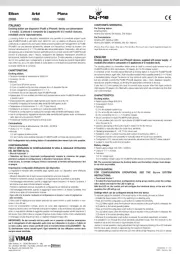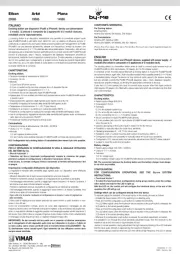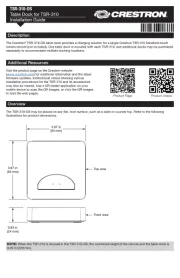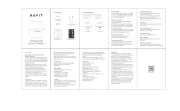Viale Vicenza, 14 - 36063 Marostica VI - Italy
Tel. +39 0424 488 600 - Fax (Italia) +39 0424 488 188
Fax (Export) +39 0424 488 709
www.vimar.com
49400362C0 01 1412
VIMAR - Marostica - Italy
ITALIANO
Docking station per dispositivi iPod e iPhone , fornita con alimentatore ® ®
- 2 moduli. (L’articolo è composto da 2 apparecchi di 2 moduli ciascuno,
installabili anche separatamente).
La docking station è un dispositivo trasmettitore che permette di connettere sorgenti audio
quali iPod (o altri lettori mp3, lettori CD, ecc.) al sistema di diffusione sonora. E’ ®/iPhone®
costituita da un apparecchio ad incasso dotato di docking station per l’alloggiamento di iPod®/
iPhone® e da una secondo apparecchio, sempre con meccanica 2 moduli da incasso, che
fornisce l’alimentazione (5 V 1A) dedicata alla carica della batteria. Il dispositivo, oltre all’invio
del segnale audio ai dispositivi ricevitori, permette anche il controllo remoto dell’iPod®/iPhone®
(funzioni di play/pause, skip+/- traccia, navigazione del database, impostazioni proprietà di
riproduzione), mediante l’invio di opportuni comandi sul bus. È inoltre presente un ingresso jack
da 3,5 mm ausiliario per il collegamento di sorgenti sonore diverse dai prodotti Apple (lettori
mp3, lettori CD, ecc.) che siano dotate di uscita stereo e controllabili esclusivamente attraverso
la propria interfaccia di comando.
CARATTERISTICHE.
Docking station.
• Tensione nominale di alimentazione: BUS 29 V
• Consumo: 35 mA
• Morsetti:
1) 2 per il bus diffusione sonora
2) 2 per un’uscita bus By-me dove collegare fino a 3 dispositivi By-me
3) 2 per collegamento caricabatteria 5 V 1 A.
• Connettore 30 poli per dispositivi Apple iPod®/iPhone®.
• Ingresso jack 3.5 mm ausiliario per lettori mp3 (autoesclusione audio iPod®/iPhone® quando
è inserito il jack).
• Disaccoppiamento galvanico degli ingressi audio rispetto al bus By-me.
• Possibilità di regolazione manuale della sensibilità dell’ingresso audio.
• Temperatura di funzionamento: 0 ÷ +45 °C (per interno)
• Installazione: a incasso o a parete (con scatola da parete 09975…)
• Pulsante di configurazione e regolazione manuale della sensibilità dell’ingresso audio.
• Led di configurazione, regolazione manuale della sensibilità dell’ingresso audio e indicazione
dello stato di funzionamento ON/OFF
• Ponticelli per inserire la terminazione di linea audio
Caricabatteria.
• Tensione nominale di alimentazione: 100-230V~ 50/60Hz
• Uscita: 5 V 1 A (max)
• Morsetti:
1) 2 per ingresso tensione di rete
2) 2 per l’uscita carica batteria dispositivi iPod connessi alla docking station®/iPhone®
N.B. Il collegamento tra la docking station e il caricabatteria deve essere il più corto possibile.
CONFIGURAZIONE.
PER LE OPERAZIONI DI CONFIGURAZIONE SI VEDA IL MANUALE ISTRUZIONI
DEL SISTEMA By-me.
• Blocchi funzionali: 1
• Selezione del blocco funzionale (configurazione): durante la creazione dei gruppi,
premere il pulsante di configurazione e attendere l’accensione del led.
A led acceso, la centrale configura il blocco funzionale; al termine dell’operazione il led
si spegne.
Impostazioni configurabili direttamente dal dispositivo
La regolazione manuale della sensibilità degli ingressi audio sul dispositivo viene effettuata
come segue:
- Attivare il dispositivo (led di stato acceso) accendendo una zona d’ascolto.
- Premere e mantenere premuto il pulsante di configurazione per aumentare la sensibilità.
Il led lampeggia velocemente; quando si raggiunge il valore massimo o si rilascia il pulsante, il
led ritorna al suo stato di funzionamento normale.
- Premere e mantenere premuto il pulsante di configurazione per diminuire la sensibilità.
Il led lampeggia lentamente; quando si raggiunge il valore minimo o si rilascia il pulsante, il led
ritorna al suo stato di funzionamento normale.
- Ogni volta che si preme il pulsante di configurazione si inverte il verso di regolazione
della sensibilità.
L’intera scala di regolazione può essere percorsa dal valore minimo a quello massimo o vice-
versa in circa 60 sec.
Come nel funzionamento normale, anche nel corso della regolazione il lampeggio ad alta
frequenza del led indica che l’intensità dell’audio in ingresso si sta avvicinando alla soglia mas-
sima. La regolazione ottimale è raggiunta quando il led lampeggia spesso ad alta frequenza: il
led acceso fisso infatti indica un segnale d’ingresso troppo basso mentre il led costantemente
in lampeggio ad alta frequenza indica un segnale d’ingresso troppo alto.
IMPORTANTE: Se dal morsetto del bus audio non è presente un’ulteriore diramazione
per il collegamento di altri dispositivi audio (cioè se il dispositivo è il primo o l’ultimo di
un ramo audio), vanno chiusi i ponticelli vicini al morsetto stesso (COLLEGAMENTI - fig.
3); diversamente vanno lasciati aperti. Ogni estremità del bus diffusione sonora deve
sempre essere terminata.
CONFORMITÀ NORMATIVA.
Per Docking station:
Direttiva EMC.
Norme EN 50428, EN 55022, EN 55024.
Per Caricabatteria:
Direttiva BT.
Direttiva EMC.
Norme EN 62684, EN 60950, EN 301 489-34.
iPhone, iPod, iPod classic, iPod nano, iPod shuffle e iPod touch sono marchi registrati di Apple Inc
negli Stati
Uniti e/o in altri paesi.
ENGLISH
Docking station for iPod® and iPhone devices, supplied with power supply - 2 ®
modules (the article is composed of 2 appliances of 2 modules each).
The docking station is a transmitter device which is used to connect audio sources such as
iPod /iPhone® ® (or other mp3 players, CD players, etc.) to the speaker system.
It comprises a flush mounted device fitted with a docking station to house the iPod®/iPhone®
and a second device, again with 2 flush mounted modules which supplies power (5 V 1A) and
a dedicated battery charger.The device not only sends an audio signal to the receiver devices,
but also remotely controls the iPod / iPhone (play/stop, skip+/- track, database navigation, ® ®
reproduction property settings), by sending the appropriate commands to the bus.
It also has a 3.5 mm auxiliary jack input to connect audio sources other than Apple products
(mp3 players, CD players, etc.) fitted with a stereo output and which are controlled only from their
own control interface.
CHARACTERISTICS.
Docking station.
• Rated supply voltage BUS 29 V.
• Consumption 35 mA.
• Terminals:
1) 2 for the speaker system bus.
2) 2 for a bus By-me output for connecting up to 3 By-me devices.
3) 2 for connecting the 5 V 1 A battery charger.
• 30-pin connector for Apple iPod®/iPhone® devices.
• 3.5 mm auxiliary jack input for mp3 players (iPod®/iPhone® audio automatically excluded
when the jack is in).
• Galvanic decoupling of the audio inputs in relation to the By-me bus.
• Possibility to manually adjust the audio input sensitivity.
• Operating temperature 0 - +45 °C (for indoor use).
• Installation: flush or surface mounting (with surface mounting box 09975…).
• Configuration button and possibility to manually adjust the audio input sensitivity.
• Configuration LED, manual audio input sensitivity adjustment and ON/OFF status indicator.
• Jumper to insert the audio line termination.
Battery charger.
• Rated supply voltage 100-230V~ 50/60Hz.
• Output 5 V 1 A (max).
• Terminals:
1) 2 for voltage input.
2) 2 for battery charger output for iPod®/iPhone® devices connected to the docking station.
NB: The connection between the docking station and the battery charger must always
be as short as possible.
CONFIGURATION.
FOR CONFIGURATION OPERATIONS, SEE THE By-me SYSTEM
INSTRUCTIONS.
• Functional blocks: 1
• To select the functional block (configuration): during group creation, press the configu-
ration button and wait for the LED to light up.
With the LED on, the control unit will configure the functional block; at the end of this
operation the LED will go out.
Settings which can be configured directly from the device
To manually adjust the sensitivity of the audio inputs on the device, proceed as follows:
- Activate the device (status LED on) by switching on a listening zone.
- Press and hold the configuration push-button to increase the sensitivity.
The LED blinks rapidly; when the maximum value is reached or the push-button is released, the
LED returns to its normal operating status.
- Press and hold the configuration push-button to decrease the sensitivity.
The LED blinks slowly; when the minimum value is reached or the push-button is released, the
LED returns to its normal operating status.
- Whenever the configuration push-button is pressed, the sensitivity adjustment is inverted.
It is possible to run through the whole sensitivity adjustment scale, from the minimum to the
maximum value and vice versa in approximately 60 sec.
Just as in normal operation, during adjustment the high-frequency blinking of the LED indicates
that the input audio intensity is approaching the maximum threshold.
The optimal setting is reached when the LED often blinks at high frequency: the LED on steady
Eikon
20585
Arké
19585
Plana
14585

















